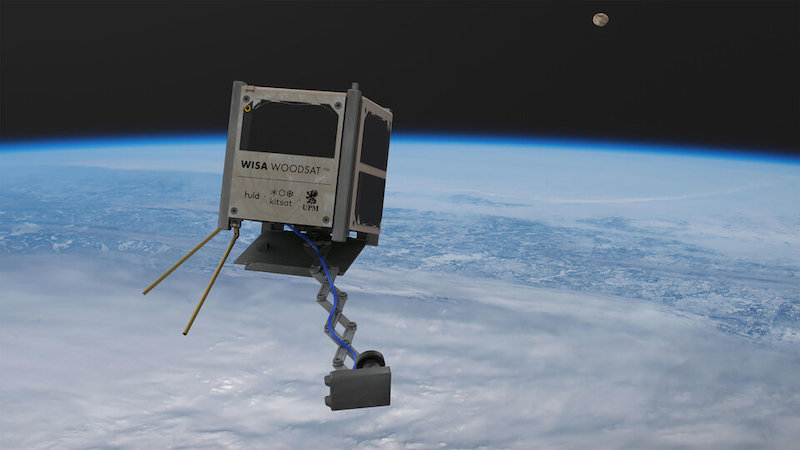
The world’s first wooden satellite will launch by the end of this year. At least, that’s the plan. The tiny satellite is called WISA Woodsat. It’ll test how plywood panels endure and behave in the extreme conditions of space. A Finnish satellite company, Arctic Astronautics, designed the satellite. Following a successful test flight on June 12, it’s now slated to lift off from the Mahia Peninsula launch complex in New Zealand by Rocket Lab – via an Electron rocket – in November 2021.
After launch, it will enter a polar orbit around Earth. If the timber-tech performs well, it could introduce an inexpensive alternative to the satellite market.
Matti Anttila, space director at the tech-design company Huld, said in a statement:
We foresee a lot of possibilities in the future by using the know-how developed in this mission.
What will the wooden satellite do?
UPM Plywood, in collaboration with Huld, manufactures the experimental material. Arctic Astronautics will gather the data. UPM said in a statement that they’ll be looking to assess:
… durability of plywood over an extended period in the harsh temperatures, vacuum, and radiation of space in order to assess the use of wood materials in space structures.
Cameras will also give the team “eyes” for assessing how the satellite’s plywood surface is holding out in the harsh space environment. Jari Mäkinen, the cofounder of Arctic Astronautics and initiator of the mission, said:
We have a pair of onboard cameras, with one extended on a selfie stick to look back at the plywood and take pictures to see how it is behaving. We want to see color changes, any cracking, and so on.
Its selfie stick is one of the few non-wooden external parts on the craft. The other is aluminum rails used for deployment.
But testing wood in space is not the satellite’s only task.
WISA Woodsat will also test some 3D-printed electrically conductive plastic material used in its design. The European Space Agency (ESA), who also had a hand in the development, said that this demonstration could pave the way for the use of different materials in space. For example, should this plastic material prove successful, future satellite projects may be able to make power and data cables using an onboard printer in space.
Nine small solar cells power the wooden satellite with enough power to run the amateur radio payload. Thus, amateur radio operators will be able to use the satellite to transfer radio signals, including images, around the world.
How will the wooden satellite survive?
ESA will contribute to WISA Woodsat’s payload by outfitting it with sensors to monitor pressure within its onboard cavities. All components in the satellite’s 4 x 4 x 4-inch (10 x 10 x 10-cm) design are made to withstand the rigors of launch and open space. ESA will also assist with the preflight testing.
Woodsat chief engineer Samuli Nyman said that aluminum oxide is another key feature in the satellite’s design. He stated:
The base material for plywood is birch, and we’re using basically just the same as you’d find in a hardware store or to make furniture. The main difference is that ordinary plywood is too humid for space uses, so we place our wood in a thermal vacuum chamber to dry it out. Then we also perform atomic layer deposition, adding a very thin aluminum oxide layer, typically used to encapsulate electronics. This should minimize any unwanted vapors from the wood, known as ‘outgassing’ in the space field, while also protecting against the erosive effects of atomic oxygen. We’ll also be testing other varnishes and lacquers on some sections of the wood.
The aluminum oxide will also protect the plywood panels from atomic oxygen, a corrosive element at the edge of Earth’s atmosphere. It’s created when UV rays strike and split oxygen molecules. NASA first discovered the damaging effect of atomic oxygen during the early Space Shuttle missions.

Past and future testing
On June 12, a first test flight of WISA Woodsat took place. It went with a weather balloon to approximately 19 miles (30 km) above Earth’s surface and into the stratosphere. It did not pass the Kármán line, though, which is the boundary separating Earth’s atmosphere from space. However, tests of its communication capabilities, command response, and selfie stick camera reportedly all passed.
On the subject of cost efficiency, ESA materials engineer Bruno Bras stated:
The good thing here is we have ended up devising a low-cost device that could find all kinds of further uses, both in orbit and down on the ground in test environments.
Bottom line: The world’s first wooden satellite, WISA Woodsat, will launch from New Zealand in November 2021, and could provide a new cost-efficient way to manufacture satellites.











